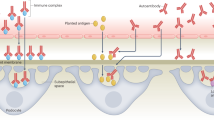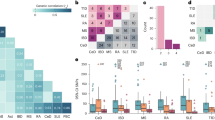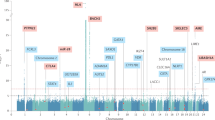Abstract
Autoimmune disease is controlled by genetic and environmental factors. Both of these affect susceptibility to autoimmunity at three levels: the overall reactivity of the immune system, the specific antigen and its presentation, and the target issue.
This is a preview of subscription content, access via your institution
Access options
Subscribe to this journal
Receive 12 print issues and online access
$209.00 per year
only $17.42 per issue
Buy this article
- Purchase on SpringerLink
- Instant access to full article PDF
Prices may be subject to local taxes which are calculated during checkout


Similar content being viewed by others
References
Jacobson, D.L., Gange, S.J., Rose, N.R. & Graham, N.M. Epidemiology and estimated population burden of selected autoimmune diseases in the United States. Clin. Immunol. Immunopathol. 84, 223–243 (1997).
Mathews, M.B. & Bernstein, R.M. Myositis autoantibody inhibits histidyl-tRNA synthetase: A model for autoimmunity. Nature 304, 177–179 (1983).
Yeaman, S.J. et al. Primary biliary cirrhosis: Identification of two major M2 mitochondrial autoantigens. Lancet 1, 1067–1070 (1988).
Matsumoto, I., Staub, A., Benoist, C. & Mathis, D. Arthritis provoked by linked T and B cell recognition of a glycolytic enzyme. Science 286, 1732–1735 (1999).
Steinman, L. Multiple sclerosis: A coordinated immunological attack against myelin in the central nervous system. Cell 85, 299–302 (1996).
Hutchings, P., O'Reilly, L., Parish, N.M., Waldmann, H. & Cooke, A. The use of a non-depleting anti-CD4 monoclonal antibody to re-establish tolerance to β cells in NOD mice. Eur J. Immunol. 22, 1913–1918 (1992).
Wong, F.S., Visintin, I., Wen, L., Flavell, R.A. & Janeway, C.A. Jr. CD8 T cell clones from young nonobese diabetic (NOD) islets can transfer rapid onset of diabetes in NOD mice in the absence of CD4 cells. J. Exp. Med. 183, 67–76 (1996).
Haskins, K. & McDuffie, M. Acceleration of diabetes in young NOD mice with a CD4+ islet-specific T cell clone. Science 249, 1433–1436 (1990).
Yu, L. et al. Antiislet autoantibodies usually develop sequentially rather than simultaneously. J. Clin. Endocrinol. Metab. 81, 4264–4267 (1996).
Kotzin, B.L. Systemic lupus erythematosus. Cell 85, 303–306 (1996).
Kotzin, B.L. et al. Use of soluble peptide-DR4 tetramers to detect synovial T cells specific for cartilage antigens in patients with rheumatoid arthritis. Proc. Natl. Acad. Sci. USA 97, 291–296 (2000).
Nakamura, R.M. Progress in the use of biochemical and biological markers for evaluation of rheumatoid arthritis. J. Clin. Lab. Anal. 14, 305–313 (2000).
Shamim, E.A. & Miller, F.W. Familial autoimmunity and the idiopathic inflammatory myopathies. Curr. Rheumatol. Rep. 2, 201–211 (2000).
Verge, C. & Eisenbarth, G.S. Autocrine polyendocrine syndromes. in Williams Textbook of Endocrinology, 9th ed. (eds. Wilson, J.D. & Forster, D.W.) (W.B. Saunders, Philadelphia, 1992).
Bernard, N.F., Ertug, F. & Margolese, H. High incidence of thyroiditis and anti-thyroid autoantibodies in NOD mice. Diabetes 41, 40–46 (1992).
Vyse, T.J. & Kotzin, B.L. Genetic susceptibility to systemic lupus erythematosus. Annu. Rev. Immunol. 16, 261–292 (1998).
Theofilopoulos, A.N. & Kono, D.H. The genes of systemic autoimmunity. Proc. Assoc. Am. Physicians 111, 228–240 (1999).
Wakeland, E.K., Wandstrat, A.E., Liu, K. & Morel, L. Genetic dissection of systemic lupus erythematosus. Curr. Opin. Immunol. 11, 701–707 (1999).
Harley, J.B., Moser, K.L., Gaffney, P.M. & Behrens, T.W. The genetics of human systemic lupus erythematosus. Curr. Opin. Immunol. 10, 690–696 (1998).
Griffiths, M.M., Encinas, J.A., Remmers, E.F., Kuchroo, V.K. & Wilder, R.L. Mapping autoimmunity genes. Curr. Opin. Immunol. 11, 689–700 (1999).
Encinas, J.A. & Kuchroo, V.K. Mapping and identification of autoimmunity genes. Curr. Opin. Immunol. 12, 691–697 (2000).
Becker, K.G. et al. Clustering of non-major histocompatibility complex susceptibility candidate loci in human autoimmune diseases. Proc. Natl. Acad. Sci. USA 95, 9979–9984 (1998).
Bergsteinsdottir, K., Yang, H.T., Pettersson, U. & Holmdahl, R. Evidence for common autoimmune disease genes controlling onset, severity, and chronicity based on experimental models for multiple sclerosis and rheumatoid arthritis. J. Immunol. 164, 1564–1568 (2000).
Vyse, T.J. & Todd, J.A. Genetic analysis of autoimmune disease. Cell 85; 311–318 (1996)
Bell, J.I. & Lathrop, G.M. Multiple loci for multiple sclerosis. Nature Genet. 13, 377–378 (1996).
Jawaheer, D. et al. A genomewide screen in multiplex rheumatoid arthritis families suggests genetic overlap with other autoimmune diseases. Am. J. Hum. Genet. 68, 927–936 (2001).
Encinas, J.A. et al. QTL influencing autoimmune diabetes and encephalomyelitis map to a 0.15-cM region containing Il2. Nature Genet. 21, 158–160 (1999).
Donner, H. et al. Codon 17 polymorphism of the cytotoxic T lymphocyte antigen 4 gene in Hashimoto's thyroiditis and Addison's disease. J. Clin. Endocrinol. Metab. 82, 4130–4132 (1997).
Holopainen, P. et al. CD28/CTLA4 gene region on chromosome 2q33 confers genetic susceptibility to celiac disease. A linkage and family-based association study. Tissue Antigens 53, 470–475 (1999).
Nagamine, K. et al. Positional cloning of the APECED gene. Nature Genet. 17, 393–398 (1997).
Horak, I., Lohler, J., Ma, A. & Smith, K.A. Interleukin-2 deficient mice: A new model to study autoimmunity and self-tolerance. Immunol. Rev. 148, 35–44 (1995).
Boillot, D., Assan, R., Dardenne, M., Debray-Sachs, M. & Bach, J.F. T-lymphopenia and T-cell imbalance in diabetic db/db mice. Diabetes 35, 198–203 (1986).
Bellgrau, D. & Lagarde, A.C. Cytotoxic T-cell precursors with low-level CD8 in the diabetes-prone Biobreeding rat: Implications for generation of an autoimmune T-cell repertoire. Proc. Natl. Acad. Sci. USA 87, 313–317 (1990).
Yunis, E.J., Fernandes, G. & Greenberg, L.J. Immune deficiency, autoimmunity and aging. Birth Defects Orig. Artic. Ser. 11, 185–192 (1975).
Goodwin, J.S., Searles, R.P. & Tung, K.S. Immunological responses of healthy elderly population. Clin. Exp. Immunol. 48, 403–410 (1982).
Sobel, E.S. et al. An intrinsic B cell defect is required for the production of autoantibodies in the lpr model of murine systemic autoimmunity. J. Exp. Med. 173, 1441–1449 (1991).
Strasser, A., Harris, A.W. & Cory, S. bcl-2 transgene inhibits T cell death and perturbs thymic self-censorship. Cell 67, 889–899 (1991).
Bolland, S. & Ravetch, J.V. Spontaneous autoimmune disease in Fc(γ)RIIB-deficient mice results from strain-specific epistasis. Immunity 13, 277–285 (2000).
Khare, S.D. et al. Severe B cell hyperplasia and autoimmune disease in TALL-1 transgenic mice. Proc. Natl. Acad. Sci. USA 97, 3370–3375 (2000).
Cornall, R.J. et al. Polygenic autoimmune traits: Lyn, CD22 and SHP-1 are limiting elements of a biochemical pathway regulating BCR signaling and selection. Immunity 8, 497–508 (1998).
Vyse, T.J., Rozzo, S.J., Drake, C.G., Izui, S. & Kotzin, B.L. Control of multiple autoantibodies linked with a lupus nephritis susceptibility locus in New Zealand black mice. J. Immunol. 158, 5566–5574 (1997).
Sobel, E.S., Mohan, C., Morel, L., Schiffenbauer, J. & Wakeland, E.K. Genetic dissection of SLE pathogenesis: Adoptive transfer of Sle1 mediates the loss of tolerance by bone marrow-derived B cells. J. Immunol. 162, 2415–2421 (1999).
Nepom, G.T. & Kwok, W.W. Molecular basis for HLA-DQ associations with IDDM. Diabetes 47, 1177–1184 (1998).
Nepom, G.T. Major histocompatibility complex-directed susceptibility to rheumatoid arthritis. Adv. Immunol. 68, 315–332 (1998).
Stratmann, T. et al. The I-Ag7 MHC class II molecule linked to murine diabetes is a promiscuous peptide binder. J. Immunol. 165, 3214–3225 (2000).
Carrasco-Marin, E., Shimizu, J., Kanagawa, O. & Unanue, E.R. The class II MHC I-Ag7 molecules from non-obese diabetic mice are poor peptide binders. J. Immunol. 156, 450–458 (1996).
Rasooly, L., Burek, C.L. & Rose, N.R. Iodine-induced autoimmune thyroiditis in NOD-H-2h4 mice. Clin. Immunol. Immunopathol. 81, 287–292 (1996).
Bennett, S.T. et al. Susceptibility to human type 1 diabetes at IDDM2 is determined by tandem repeat variation at the insulin gene minisatellite locus. Nature Genet. 9, 284–292 (1995).
Vafiadis, P. et al. Insulin expression in human thymus is modulated by INS VNTR alleles at the IDDM2 locus. Nature Genet. 15, 289–292 (1997).
Klein, L., Klugmann, M., Nave, K.A., Tuohy, V.K. & Kyewski, B. Shaping of the autoreactive T-cell repertoire by a splice variant of self protein expressed in thymic epithelial cells. Nature Med. 6, 56–61 (2000).
Anderson, A.C. et al. High frequency of autoreactive myelin proteolipid protein-specific T cells in the periphery of naive mice: Mechanisms of selection of the self-reactive repertoire. J. Exp. Med. 191, 761–770 (2000).
Botto, M. et al. Homozygous C1q deficiency causes glomerulonephritis associated with multiple apoptotic bodies. Nature Genet. 19, 56–59 (1998).
Slingsby, J.H. et al. Homozygous hereditary C1q deficiency and systemic lupus erythematosus. A new family and the molecular basis of C1q deficiency in three families. Arthritis Rheum. 39, 663–670 (1996).
Streilein, J.W., Wilbanks, G.A. & Cousins, S.W. Immunoregulatory mechanisms of the eye. J. Neuroimmunol. 39, 185–200 (1992).
Griffith, T.S., Brunner, T., Fletcher, S.M., Green, D.R. & Ferguson, T.A. Fas ligand-induced apoptosis as a mechanism of immune privilege. Science 270, 1189–1192 (1995).
Salmon, J.E. et al. Fc-γ RIIA alleles are heritable risk factors for lupus nephritis in African Americans. J. Clin. Invest. 97, 1348–1354 (1996).
Wu, J. et al. A novel polymorphism of FcγRIIIa (CD16) alters receptor function and predisposes to autoimmune disease. J. Clin. Invest. 100, 1059–1070 (1997).
Clynes, R., Dumitru, C. & Ravetch, J.V. Uncoupling of immune complex formation and kidney damage in autoimmune glomerulonephritis. Science 279, 1052–1054 (1998).
Vyse, T.J. et al. Genetic linkage of IgG autoantibody production in relation to lupus nephritis in New Zealand hybrid mice. J. Clin. Invest. 98, 1762–1772 (1996).
Kuan, A.P. et al. Genetic control of autoimmune myocarditis mediated by myosin-specific antibodies. Immunogenetics 49, 79–85 (1999).
Chiller, J.M., Skidmore, B.J., Morrison, D.C. & Weigle, W.O. Relationship of the structure of bacterial lipopolysaccharides to its function in mitogenesis and adjuvanticity. Proc. Natl. Acad. Sci. USA 70, 2129–2133 (1973).
Kearney, E.R., Pape, K.A., Loh, D.Y. & Jenkins, M.K. Visualization of peptide-specific T cell immunity and peripheral tolerance induction in vivo. Immunity 1, 327–339 (1994).
Vella, A.T. et al. CD28 engagement and proinflammatory cytokines contribute to T cell expansion and long-term survival in vivo. J. Immunol. 158, 4714–4720 (1997).
Tanaka, H., Demeure, C.E., Rubio, M., Delespesse, G. & Sarfati, M. Human monocyte-derived dendritic cells induce naive T cell differentiation into T helper cell type 2 (Th2) or Th1/Th2 effectors. Role of stimulator/responder ratio. J. Exp. Med. 192, 405–412 (2000).
Cumberbatch, M. & Kimber, I. Tumour necrosis factor-α is required for accumulation of dendritic cells in draining lymph nodes and for optimal contact sensitization. Immunology 84, 31–35 (1995).
Segal, B.M., Klinman, D.M. & Shevach, E.M. Microbial products induce autoimmune disease by an IL-12-dependent pathway. J. Immunol. 158, 5087–5090 (1997).
Brackertz, D., Mitchell, G.F. & Mackay, I.R. Antigen-induced arthritis in mice. I. Induction of arthritis in various strains of mice. Arthritis Rheum. 20, 841–850 (1977).
Esquivel, P.S., Rose, N.R. & Kong, Y.C. Induction of autoimmunity in good and poor responder mice with mouse thyroglobulin and lipopolysaccharide. J. Exp. Med. 145, 1250–1263 (1977).
Lucey, D.R., Clerici, M. & Shearer, G.M. Type 1 and type 2 cytokine dysregulation in human infectious, neoplastic, and inflammatory diseases. Clin. Microbiol. Rev. 9, 532–562 (1996).
Sher, A. et al. Cytokines as determinants of disease and disease interactions. Braz. J. Med. Biol. Res. 31, 85–87 (1998).
Romagnani, S. Th1/Th2 cells. Inflamm. Bowel Dis. 5, 285–94 (1999).
Theofilopoulos, A.N. & Lawson, B.R. Tumour necrosis factor and other cytokines in murine lupus. Ann. Rheum. Dis. 58 (Suppl. 1), I49–55 (1999).
Gross, D.M. et al. Identification of LFA-1 as a candidate autoantigen in treatment-resistant Lyme arthritis. Science 281, 703–706 (1998).
Dell, A. et al. Autoimmune determinants of rheumatic carditis: Localization of epitopes in human cardiac myosin. Eur. Heart J. 12 (Suppl. D), 158–62 (1991).
Schloot, N.C. et al. Molecular mimicry in type 1 diabetes mellitus revisited: T-cell clones to GAD65 peptides with sequence homology to Coxsackie or proinsulin peptides do not crossreact with homologous counterpart. Hum. Immunol. 62, 299–309 (2001).
Davies, J.M. Molecular mimicry: Can epitope mimicry induce autoimmune disease? Immunol. Cell Biol. 75, 113–126 (1997).
Ringrose, J.H. HLA-B27 associated spondyloarthropathy, an autoimmune disease based on crossreactivity between bacteria and HLA-B27? Ann. Rheum. Dis. 58, 598–610 (1999).
Jakobiec, F.A., Lefkowitch, J. & Knowles, D.M., 2nd. B- and T-lymphocytes in ocular disease. Ophthalmology 91, 635–654 (1984).
Konno, N., Makita, H., Yuri, K., Iizuka, N. & Kawasaki, K. Association between dietary iodine intake and prevalence of subclinical hypothyroidism in the coastal regions of Japan. J. Clin. Endocrinol. Metab. 78, 393–397 (1994).
Miller, S.D. et al. Persistent infection with Theiler's virus leads to CNS autoimmunity via epitope spreading. Nature Med. 3, 1133–1136 (1997).
Mach, F. et al. Functional CD40 ligand is expressed on human vascular endothelial cells, smooth muscle cells, and macrophages: Implications for CD40–CD40 ligand signaling in atherosclerosis. Proc. Natl. Acad. Sci. USA 94, 1931–1936 (1997).
Hogaboam, C.M., Snider, D.P. & Collins, S.M. Cytokine modulation of T-lymphocyte activation by intestinal smooth muscle cells. Gastroenterology 112, 1986–1995 (1997).
Seko, Y. et al. Expression of costimulatory molecule CD40 in murine heart with acute myocarditis and reduction of inflammation by treatment with anti-CD40L/B7-1 monoclonal antibodies. Circ. Res. 83, 463–469 (1998).
Poltorak, A. et al. Genetic and physical mapping of the Lps locus: Identification of the toll-4 receptor as a candidate gene in the critical region. Blood Cells Mol. Dis. 24, 340–355 (1998).
Locksley, R.M. et al. Development of CD4+ effector T cells and susceptibility to infectious diseases. Adv Exp. Med. Biol. 452, 45–52 (1998).
Cook, H.B. et al. Adult coeliac disease: Prevalence and clinical significance. J. Gastroenterol Hepatol. 15, 1032–1036 (2000).
Kennedy, N.P. & Feighery, C. Clinical features of coeliac disease today. Biomed. Pharmacother. 54, 373–380 (2000).
Edelson, R.L. Pemphigus—decoding the cellular language of cutaneous autoimmunity. N. Engl. J. Med. 343, 60–61 (2000).
Quayle, A.J. et al. Peptide recognition, T cell receptor usage and HLA restriction elements of human heat-shock protein (hsp) 60 and mycobacterial 65-kDa hsp-reactive T cell clones from rheumatoid synovial fluid. Eur J. Immunol. 22, 1315–1322 (1992).
Ufret-Vincenty, R.L. et al. In vivo survival of viral antigen-specific T cells that induce experimental autoimmune encephalomyelitis. J. Exp. Med. 188, 1725–1738 (1998).
Kukreja, A. & Maclaren, N.K. Current cases in which epitope mimicry is considered as a component cause of autoimmune disease: Immune-mediated (type 1) diabetes. Cell. Mol. Life Sci. 57, 534–541 (2000).
Hiemstra, H.S. et al. Cytomegalovirus in autoimmunity: T cell crossreactivity to viral antigen and autoantigen glutamic acid decarboxylase. Proc. Natl. Acad. Sci. USA 98, 3988–3991 (2001).
Shimoda, S. et al. Mimicry peptides of human PDC-E2 163–176 peptide, the immunodominant T-cell epitope of primary biliary cirrhosis. Hepatology 31, 1212–1216 (2000).
Albani, S., Tuckwell, J.E., Esparza, L., Carson, D.A. & Roudier, J. The susceptibility sequence to rheumatoid arthritis is a cross-reactive B cell epitope shared by the Escherichia coli heat shock protein dnaJ and the histocompatibility leukocyte antigen DRB10401 molecule. J. Clin. Invest. 89, 327–331 (1992).
Albani, S., Carson, D.A. & Roudier, J. Genetic and environmental factors in the immune pathogenesis of rheumatoid arthritis. Rheum. Dis. Clin. North Am. 18, 729–740 (1992).
Wucherpfennig, K.W. & Strominger, J.L. Molecular mimicry in T cell-mediated autoimmunity: Viral peptides activate human T cell clones specific for myelin basic protein. Cell 80, 695–705 (1995).
Bachmaier, K. et al. Chlamydia infections and heart disease linked through antigenic mimicry. Science 283, 1335–1339 (1999).
Masuda, M.O. et al. Functionally active cardiac antibodies in chronic Chagas' disease are specifically blocked by Trypanosoma cruzi antigens. FASEB J. 12, 1551–1558 (1998).
Schwimmbeck, P.L., Dyrberg, T., Drachman, D.B. & Oldstone, M.B. Molecular mimicry and myasthenia gravis. An autoantigenic site of the acetylcholine receptor α-subunit that has biologic activity and reacts immunochemically with herpes simplex virus. J. Clin. Invest. 84, 1174–1180 (1989)
Acknowledgements
This work was supported by NIH grants AI-17134, AI-18785, AI-22295 and AR-37070.
Author information
Authors and Affiliations
Rights and permissions
About this article
Cite this article
Marrack, P., Kappler, J. & Kotzin, B. Autoimmune disease: why and where it occurs. Nat Med 7, 899–905 (2001). https://doi.org/10.1038/90935
Issue Date:
DOI: https://doi.org/10.1038/90935
This article is cited by
-
Chemical synthesis as a discovery platform in immunosuppression and determination of mode of action
Nature Synthesis (2024)
-
Neurocognitive effects of stress: a metaparadigm perspective
Molecular Psychiatry (2023)
-
Association between functional FCGR3A F158V and FCGR2A R131H polymorphisms and responsiveness to rituximab in patients with autoimmune diseases: a meta-analysis
The Pharmacogenomics Journal (2023)
-
Modic change is associated with increased BMI but not autoimmune diseases in TwinsUK
European Spine Journal (2023)
-
Prediction of diagnosis results of rheumatoid arthritis patients based on autoantibodies and cost-sensitive neural network
Clinical Rheumatology (2022)



